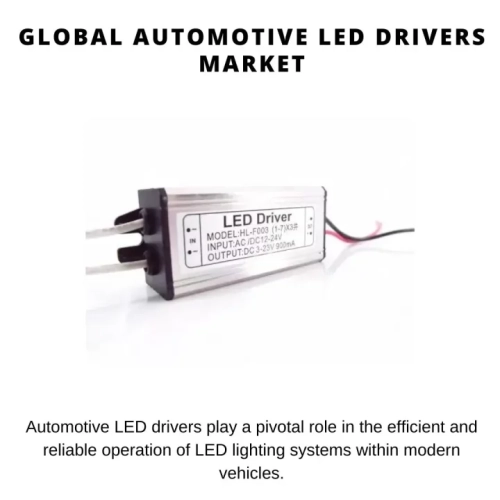
- Get in Touch with Us

Last Updated: Apr 25, 2025 | Study Period: 2024-2030
Automotive LED drivers play a pivotal role in the efficient and reliable operation of LED lighting systems within modern vehicles. As automotive lighting technology evolves, the demand for high-performance and energy-efficient LED lighting solutions increases.
LED drivers serve as the crucial link between the vehicle's electrical system and the LED lighting modules, ensuring optimal performance, safety, and longevity of the lighting system.
In the past, traditional incandescent bulbs were commonly used in automotive lighting. However, due to their inefficiency and shorter lifespan, automotive manufacturers have shifted towards LED lighting as a superior alternative.
LEDs (Light Emitting Diodes) offer numerous advantages, including lower power consumption, longer operational life, faster response times, and enhanced design flexibility. These characteristics make LEDs ideal for various automotive lighting applications, such as headlights, taillights, daytime running lights, and interior lighting.

Automotive LED drivers are specialized electronic devices designed to regulate the electrical current supplied to LEDs, enabling them to operate at their optimal conditions.
LEDs are sensitive to current and voltage fluctuations, so precise control is necessary to maintain their performance and extend their lifespan. LED drivers ensure that LEDs receive a stable and constant current, protecting them from voltage spikes or drops that could otherwise cause premature failure.
One of the primary functions of automotive LED drivers is to convert the vehicle's electrical power supply to the appropriate voltage and current levels required by the LEDs.
Vehicles typically operate on a 12V or 24V electrical system, while LEDs often require lower voltages to operate efficiently. LED drivers use various techniques, such as pulse-width modulation (PWM) and constant current regulation, to step down the voltage and maintain a steady current flow to the LEDs.
The ability of LED drivers to provide constant current is especially crucial in automotive lighting applications. Unlike incandescent bulbs, LEDs do not have a linear current-voltage characteristic, meaning that a small change in voltage can result in a significant change in current.
This sensitivity can lead to uneven brightness and color shifts in the LEDs. Automotive LED drivers ensure uniform illumination by maintaining a consistent current, resulting in evenly distributed light output across the LED modules.
Furthermore, automotive LED drivers incorporate advanced control features that enhance safety and functionality. For instance, some LED drivers support dimming capabilities, allowing drivers to adjust the brightness of the LEDs according to specific driving conditions or preferences.
Dimming is particularly useful for interior lighting and adaptive lighting systems that can automatically adjust brightness based on ambient light or traffic conditions.
Safety is paramount in automotive design, and LED drivers play a crucial role in ensuring safe and reliable lighting. They are equipped with various protection mechanisms to safeguard against overcurrent, overvoltage, and overheating.
These protective features prevent potential hazards, such as short circuits, and contribute to the overall safety of the vehicle's electrical system.
In addition to safety, automotive LED drivers must also meet stringent requirements for electromagnetic compatibility (EMC). Vehicles are environments with numerous electronic systems, and ensuring that LED drivers do not interfere with other electronic components or experience interference from them is essential.
Compliant LED drivers are carefully designed and tested to minimize electromagnetic interference, ensuring that the lighting system functions reliably without affecting other vehicle systems.
Another critical aspect of automotive LED drivers is their thermal management capabilities. LEDs are sensitive to heat, and excessive temperatures can significantly degrade their performance and lifespan.
LED drivers are designed with efficient heat dissipation mechanisms to manage the heat generated during operation effectively. This ensures that the LEDs remain within their recommended temperature range, contributing to their longevity and consistent performance.
As automotive LED technology advances, so do the requirements for LED drivers. Manufacturers are continually working to improve efficiency, miniaturize components, and integrate additional features into LED drivers.
Future developments may include smart LED drivers with built-in communication interfaces, enabling seamless integration with vehicle networks and control systems.
In conclusion, automotive LED drivers are critical components that facilitate the efficient and reliable operation of LED lighting systems in modern vehicles.
They convert the vehicle's electrical power supply to the appropriate voltage and current levels required by the LEDs while ensuring stable illumination and protecting the LEDs from voltage fluctuations. Automotive LED drivers also incorporate advanced features like dimming and various safety and protection mechanisms to enhance functionality and safety.
Additionally, complying with electromagnetic compatibility standards and effective thermal management contribute to the overall performance and longevity of automotive LED drivers.
As the automotive industry continues to embrace LED lighting for its numerous benefits, the importance of high-quality LED drivers will remain paramount in delivering safe, efficient, and innovative lighting solutions for vehicles.

The Global Automotive LED Drivers Market accounted for $XX Billion in 2023 and is anticipated to reach $XX Billion by 2030, registering a CAGR of XX% from 2024 to 2030.
Infineon Technologies recently launched its Smart Hybrid LED Driver, which is designed to improve the efficiency and performance of automotive LED lighting systems.
The driver uses a hybrid architecture that combines a digital controller with a power MOSFET, which allows it to achieve a high level of efficiency while also providing the necessary power to drive LEDs.
The driver also features a number of advanced features, such as dimming control, fault detection, and thermal management.The Smart Hybrid LED Driver from Infineon Technologies uses a hybrid architecture that combines a digital controller with a power MOSFET.
The digital controller is responsible for controlling the LED current and voltage, while the power MOSFET provides the necessary power to drive the LEDs. This hybrid architecture allows the driver to achieve a high level of efficiency while also providing the necessary power to drive LEDs.
Osram Opto Semiconductors recently launched its Digital LED Driver, which is designed to provide a high level of performance and flexibility for automotive LED lighting systems.
The driver uses a digital control loop that allows it to precisely control the LED current and voltage, which results in a high level of efficiency. The driver also features a number of advanced features, such as dimming control, fault detection, and thermal management.
The Digital LED Driver from Osram Opto Semiconductors uses a digital control loop to precisely control the LED current and voltage. This results in a high level of efficiency, as well as the ability to precisely control the brightness of the LEDs.
The driver also features a number of advanced features, such as dimming control, fault detection, and thermal management.
Renesas Electronics recently launched its LED Driver IC, which is designed to simplify the design of automotive LED lighting systems. The IC integrates a number of functions, such as LED current control, dimming control, and fault detection, which eliminates the need for external components.
The IC also features a number of advanced features, such as thermal management and protection against overvoltage and overcurrent.
The LED Driver IC from Renesas Electronics integrates a number of functions, such as LED current control, dimming control, and fault detection.
This eliminates the need for external components, which simplifies the design of automotive LED lighting systems. The IC also features a number of advanced features, such as thermal management and protection against overvoltage and overcurrent.
| Sl no | Topic |
| 1 | Market Segmentation |
| 2 | Scope of the report |
| 3 | Abbreviations |
| 4 | Research Methodology |
| 5 | Executive Summary |
| 6 | Introduction |
| 7 | Insights from Industry stakeholders |
| 8 | Cost breakdown of Product by sub-components and average profit margin |
| 9 | Disruptive innovation in the Industry |
| 10 | Technology trends in the Industry |
| 11 | Consumer trends in the industry |
| 12 | Recent Production Milestones |
| 13 | Component Manufacturing in US, EU and China |
| 14 | COVID-19 impact on overall market |
| 15 | COVID-19 impact on Production of components |
| 16 | COVID-19 impact on Point of sale |
| 17 | Market Segmentation, Dynamics and Forecast by Geography, 2024-2030 |
| 18 | Market Segmentation, Dynamics and Forecast by Product Type, 2024-2030 |
| 19 | Market Segmentation, Dynamics and Forecast by Application, 2024-2030 |
| 20 | Market Segmentation, Dynamics and Forecast by End use, 2024-2030 |
| 21 | Product installation rate by OEM, 2023 |
| 22 | Incline/Decline in Average B-2-B selling price in past 5 years |
| 23 | Competition from substitute products |
| 24 | Gross margin and average profitability of suppliers |
| 25 | New product development in past 12 months |
| 26 | M&A in past 12 months |
| 27 | Growth strategy of leading players |
| 28 | Market share of vendors, 2023 |
| 29 | Company Profiles |
| 30 | Unmet needs and opportunity for new suppliers |
| 31 | Conclusion |
| 32 | Appendix |